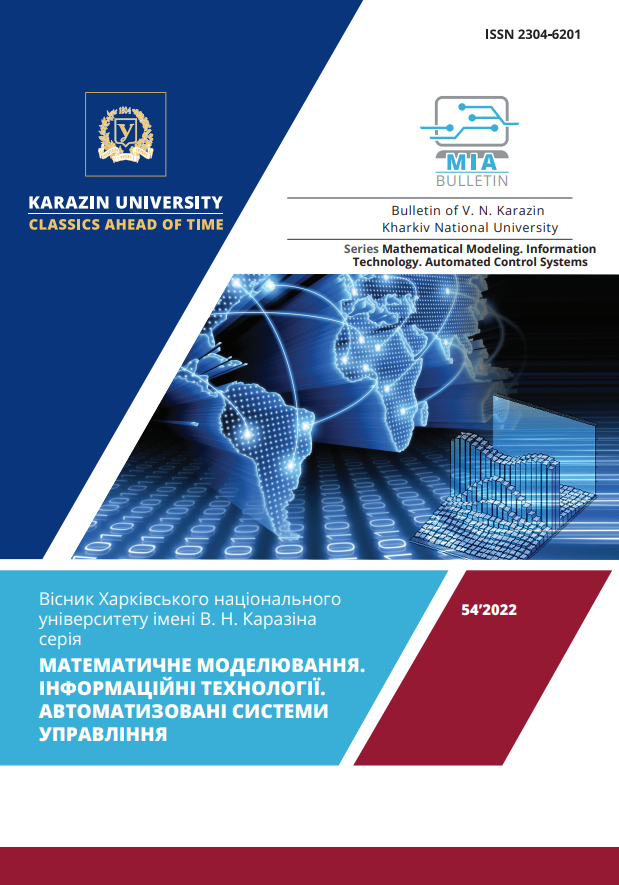Mathematical modeling of the dynamics of aquatic ecosystems and the possibilities of their self-cleaning at the conditions of global climate change
Abstract
A detailed review of mathematical models of pollution dispersion in air, water and soil is presented in the article. The models are represented by the systems of differential equations and used for water resources management on urban landscapes. Detailed three-dimensional equations of mass, momentum and heat transfer, averaged two-dimensional dispersion models on terrain maps, one-dimensional dispersion models in river systems and zero-dimensional compartmental models have been considered. The biotic component and the impact of the effects of gradual global climate change have been taken into account. The tasks for external quality management of water, air and soil, as well as the possibilities of the ecosystem for self-management have been considered. The problems of fuzzy data for validation as well as the usage of mathematical models for practical purposes have been discussed.
Downloads
References
/References
Mathematical modeling of water quality: Streams, lakes, and reservoirs. Ed. by G.T. Orlob. J. Willey&Sons. 1983. 518 p. http://pure.iiasa.ac.at/id/eprint/2144/
N. Kizilova, N. Rychak, D. Chebukin, M. Lukijenko, Ecological assessment of surface water quality in the rainless period in the conditions of urban catchment, Bulletin of Kharkiv National University named after VN Karazina, Ser. "Geology. Geography. Ecology", 2021. N54. P.289-305. https://doi.org/10.26565/2410-7360-2021-54-22
N. Rychak, N. Kizilova, Modeling of surface water quality in the conditions of urban geosystem, “Advanced discoveries of modern science: experience, approaches and innovations.” Proceedings of I International Scientific and Theoretical Conference, April 9, 2021. Amsterdam, the Netherlands: European Scientific Platform. 2021. Vol.1. P. 130-133. doi:10.36074/scientia-09.04.2021
N. Rychak, N. Kizilova, Environmental consequences of global climate change in urban areas, Environmental sciences, 2021, Vol.4(37), P.165-170. doi : 10.32846/2306-9716/2021.eco.4-37.25
Climate Change 2021. The Physical Science Basis. IPCC Report. WGI Press, 2021, 3949 p. [Електронний ресурс: https://www.ipcc.ch/report/ar6/wg1/downloads/report/IPCC_AR6_WGI_Full_Report.pdf]
WASP [Електронний ресурс: https://www.epa.gov/ceam/water-quality-analysis-simulation-program-wasp]
R.B. Ambrose, “A Hydrodynamic and Water Quality Model. Theory, User’s Manual, and Programmer’s Guide”, USEPA, Athens. 1988. https://nepis.epa.gov/ZyPURL
OpenGeoSys. Open-source multi-physics [Електронний ресурс: https://www.opengeosys.org/]
O. Kolditz, Computational methods in environmental fluid mechanics. Springer. 2002. 378 p. https://link.springer.com/book/10.1007/978-3-662-04761-3
Mathematical modeling of water quality: Streams, lakes, and reservoirs. Ed. by G.T. Orlob. J. Willey&Sons. 1983. 518 p. http://pure.iiasa.ac.at/id/eprint/2144/
Кізілова Н.М., Ричак Н.Л., Чебукін Д.С., Лукієнко М.В. Екологічна оцінка якості поверхневих вод у бездощовий період в умовах міського водозбору. Вісник Харківського національного університету імені В.Н. Каразіна, сер. «Геологія. Географія. Екологія». 2021. N54. P.289-305. https://doi.org/10.26565/2410-7360-2021-54-22
Ричак Н.Л., Кізілова Н.М. Моделювання якості поверхневих вод в умовах урболадшафтної геосистеми. “Advanced discoveries of modern science: experience, approaches and innovations.” Proceedings of I International Scientific and Theoretical Conference, April 9, 2021. Amsterdam, the Netherlands: European Scientific Platform. 2021. Vol.1. P. 130-133. doi:10.36074/scientia-09.04.2021
Ричак Н.Л., Кізілова Н.М. Екологічні наслідки глобальних змін клімату на урбанізованих територіях. Екологічні науки. 2021. Вип.4(37). С.165-170. doi : 10.32846/2306-9716/2021.eco.4-37.25
Climate Change 2021. The Physical Science Basis. IPCC Report. WGI Press. 2021. 3949p. [https://www.ipcc.ch/report/ar6/wg1/downloads/report/IPCC_AR6_WGI_Full_Report.pdf]
WASP [Електронний ресурс: https://www.epa.gov/ceam/water-quality-analysis-simulation-program-wasp]
Ambrose R.B. A Hydrodynamic and Water Quality Model. Theory, User’s Manual, and Programmer’s Guide. USEPA, Athens. 1988. https://nepis.epa.gov/ZyPURL
OpenGeoSys. Open-source multi-physics [Електронний ресурс: https://www.opengeosys.org/]
Kolditz O. Computational methods in environmental fluid mechanics. Springer. 2002. 378 p. https://link.springer.com/book/10.1007/978-3-662-04761-3




